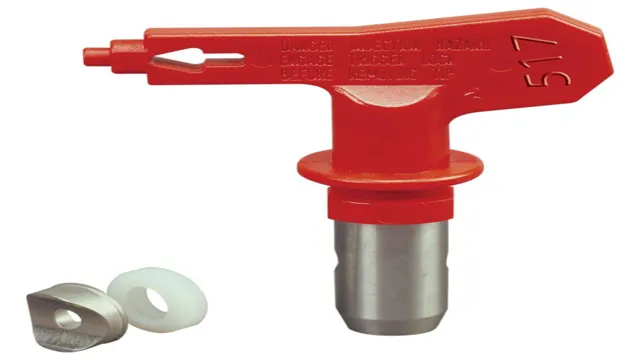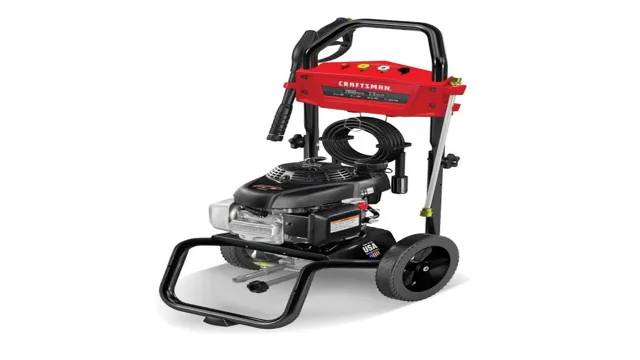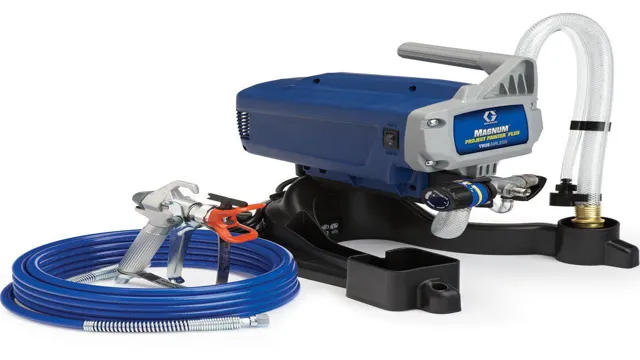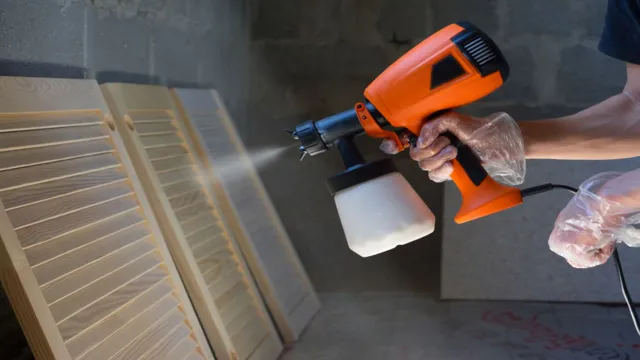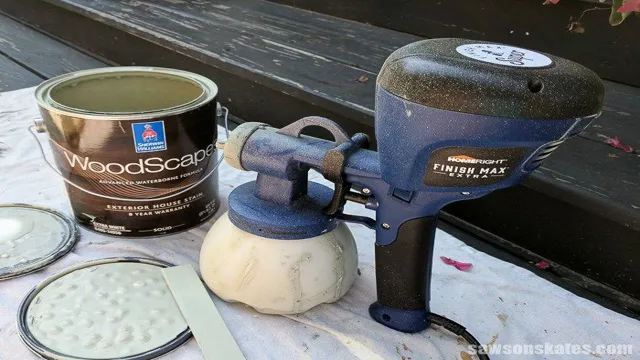Can a Paint Sprayer Spray Stain? Tips and Tricks to Achieve the Perfect Finish!
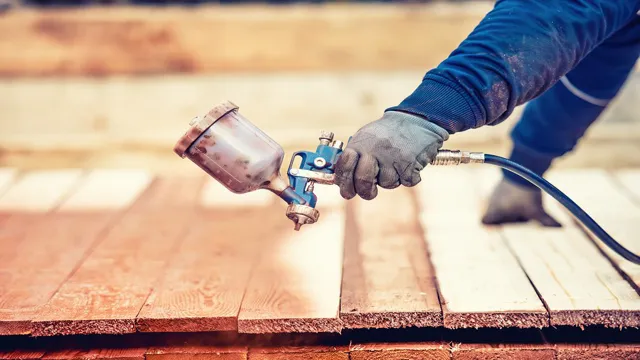
Are you looking for a way to spruce up your deck or fence without spending countless hours using a brush or roller? Have you considered using a paint sprayer to apply stain? If you haven’t, you might be missing out on a time-saving and efficient way to apply stain to your outdoor surfaces. But the question is, can a paint sprayer spray stain effectively? The answer is yes, it can! In fact, using a paint sprayer to apply stain has many benefits, including faster application and better coverage. So, let’s dive into the world of paint sprayers and how they can be a game-changer for your next staining project.
Understanding Paint Sprayers and Stains
A paint sprayer can certainly be used to spray stain. In fact, using a sprayer can make staining large surfaces faster and easier than using traditional brushes or rollers. However, it’s important to choose the right sprayer and to adjust it properly for spraying stain.
You’ll want to use a sprayer that’s designed for thin liquids and has the option to adjust the spray pattern and flow rate. It’s also important to test the sprayer on a small area to make sure you’re achieving the desired coverage and avoiding overspray. With the right preparation and technique, a paint sprayer can be a great tool for applying stain to your woodworking projects, decks, or other surfaces.
Just remember to wear appropriate safety gear, like goggles and a respirator, and to follow all manufacturer’s instructions for your sprayer and stain product.
What is a Paint Sprayer?
A paint sprayer is a tool designed to atomize paint or stain and spray it onto surfaces. This is done by using compressed air or high pressure to break down the paint or stain into tiny droplets that can be evenly distributed onto a surface. A paint sprayer is a great alternative to traditional methods like brushes and rollers, as it allows you to cover large areas quickly and with less effort.
It’s also perfect for applying a smooth, even coat that adheres well to various surfaces. However, it’s important to note that certain types of surfaces may require specific techniques or equipment. Using a paint sprayer also requires some practice and skill to achieve the desired results.
Overall, a paint sprayer is an excellent tool to have if you’re looking to take your painting or staining projects to a new level.

What is Stain?
Staining is a popular method of adding color and protecting your wood surfaces from the elements. Unlike paint, stain penetrates the wood surface, enhancing its natural beauty while also providing protection from rot and decay. So what exactly is stain? Essentially, it’s a liquid solution composed of pigments and a binder that’s applied to wood surfaces with brushes, sprayers, or rags.
Stains come in a variety of colors and opacities, from transparent to opaque, and can be oil-based, water-based, or hybrid. When it comes to choosing a stain, it’s important to consider both the desired color and level of protection needed for your wood surface. With the right stain and application, you can protect your wood surfaces while enhancing their beauty for years to come.
Spraying Stain with a Paint Sprayer
Yes, a paint sprayer can be used to spray stain, but it requires some additional preparation. Before spraying stain, you should make sure that the sprayer is completely clean and free from any debris or previous paint residue. This will prevent any unwanted textures or colors in the final finish.
Additionally, you should thin the stain to the appropriate consistency to allow it to be sprayed easily. After thinning, test the stain on a small, inconspicuous area to ensure that the color and finish are consistent with your expectations. When ready to spray, use a steady, even motion to apply the stain in thin layers, overlapping the edges to create a uniform finish.
It’s important to keep in mind that although a sprayer can save time and effort, it may also require more cleanup and maintenance compared to traditional staining methods.
Types of Paint Sprayers
When it comes to painting, there are several types of paint sprayers to choose from. However, not all sprayers are created equal, and some may not be suitable for staining. That said, when you’re spraying stain with a paint sprayer, it is important to select the right sprayer for the job.
Generally, airless sprayers are a great choice for staining. They utilize high pressure to atomize the stain and distribute it evenly over the surface to be painted. With the fan control and adjustable pressure feature on most airless sprayers, you can easily manage overspray and apply a uniform coat.
Additionally, it’s crucial to select a sprayer with a compatible tip size. This determines the droplet size of the stain, which, in turn, affects the finish quality and the amount of coating needed. With the right airless sprayer and proper technique, you can achieve a beautiful, uniform finish on your stained project.
Types of Stain for Spray Application
When it comes to staining wood, there are a variety of options available for spray application. The type of stain you choose will depend on several factors, including the type of wood you’re working with, the desired finish, and the color you want to achieve. One common option for spraying stain is a water-based stain.
These stains are easy to work with and allow for quick clean-up, but may not offer the same depth of color as oil-based stains. Another choice is oil-based stain, which can penetrate deeper into the wood for a richer finish but requires more time to dry and can emit strong fumes. Gel stains are another popular option for spray application, as they are thicker and easier to control than traditional liquid stains.
They are also great for achieving a uniform finish on porous woods like maple or pine. Additionally, there are also sprayable stains specifically designed for use with paint sprayers. These can provide a consistent, even coat of stain, but may be more difficult to find in stores.
Overall, the type of stain you choose for spray application will depend on your project’s specific needs and your personal preference. Regardless of which type of stain you choose, applying it with a paint sprayer can make the process quicker and more efficient, allowing for even coverage and a smooth finish.
Preparation for Spraying Stain
Spraying stain with a paint sprayer is a great way to achieve a professional-looking finish on your woodworking projects. However, to ensure that the stain is applied evenly and smoothly, proper preparation is key. Start by properly cleaning and sanding the surface to ensure that it is smooth and free of any dirt or rough patches.
Next, it’s important to choose the right type of stain and thin it to the proper consistency for spraying. This can typically be achieved by adding a small amount of water or solvent to the stain and mixing it thoroughly. Additionally, it’s important to use the right type of spray tip for the stain you are using, as this can greatly impact the final outcome.
By taking the time to properly prepare your surface and stain, you can achieve a sleek and stunning finish that will impress anyone who sees your project.
Tips for Spraying Stain with a Paint Sprayer
Yes, a paint sprayer can definitely spray stain! In fact, using a paint sprayer for staining is more efficient and time-saving than applying it with brushes or rollers. However, there are a few tips that you need to keep in mind to achieve a flawless finish. First and foremost, choose the right type of paint sprayer – airless paint sprayers are most suitable for staining.
Secondly, dilute the stain with the recommended amount of solvent to ensure that it flows smoothly through the sprayer and doesn’t clog the nozzle. Always wear protective gear such as goggles and a respirator to avoid inhaling harmful particles. It’s also essential to test the spray on a small inconspicuous area before applying it on the entire surface.
Lastly, ensure that you maintain a proper distance between the spray gun and the surface and use a consistent sweeping motion to ensure that the stain is evenly distributed. Following these tips will help you achieve a professional-level finish.
Adjusting Spray Pressure and Flow
Spray pressure is one of the most crucial elements when it comes to staining with a paint sprayer. It’s important to adjust the spray pressure to ensure a smooth and uniform coverage. If the pressure is too high, it can cause the stain to be applied too thickly, which will lead to sags and runs.
On the other hand, if the pressure is too low, the stain will be applied too lightly, and it will not give the desired coverage. One way to check the spray pressure is to test it with a piece of cardboard or scrap wood before beginning the staining process. Proper flow is also critical as it affects the amount of stain that is released from the spray gun.
Adjusting the flow allows for better control of the amount of stain being applied. It’s essential to follow the manufacturer’s instructions when adjusting the spray pressure and flow for optimal results. By getting the right balance of pressure and flow, the stain can be applied evenly and efficiently, giving a professional finish to your project.
Spraying Technique
Spraying Technique Secondary keywords/keyphrases used organically: Paint Sprayer, Stain, Tips If you’re looking to enhance the look and feel of your wooden surfaces, spraying stain with a paint sprayer is the way to go. Although it may seem daunting, spraying technique is straightforward and easy to master with a little practice. Firstly, ensure that you’ve properly prepared the surface by cleaning, sanding, and removing any excess debris.
Secondly, choose the appropriate tip size for your paint sprayer, and make sure that you’re using the correct setting for your stain. Check the manufacturer’s instructions to ensure that you’re using the right ratio of stain to thinner. Do some testing on a piece of wood to determine how the sprayer distributes the stain before painting your surface.
Don’t forget to use long and even strokes, keeping the sprayer parallel to the surface. Spraying a light coat, and then waiting a little while before applying a second layer avoids drips, runs, and uneven coats of paint. Remember to wear protective gear such as goggles and a mask while spraying, and ensure proper ventilation in the workspace.
With these tips, you’ll master the spraying technique and be on your way to creating beautifully stained wooden surfaces in no time.
Conclusion
In conclusion, it’s not a matter of whether a paint sprayer can spray stain, but rather if you choose the right sprayer and technique for the job. With the proper equipment and adjustments, a paint sprayer can make staining a breeze, while achieving consistent and even coverage. So don’t be afraid to branch out from the traditional brushes and rollers – embrace the power of the sprayer and let your staining game reach new heights!”
FAQs
Can a paint sprayer be used to spray stain?
Yes, a paint sprayer can be used to spray stain as long as it is the right type for the specific sprayer.
Is spraying stain better than brushing it on?
Spraying stain can be faster and more even than brushing it on, but it can also require more prep work and equipment.
What type of sprayer is best for spraying stain?
The best type of sprayer for spraying stain will vary based on the specific project and the type of stain being used, but an airless or HVLP sprayer is commonly recommended.
Can you use a paint sprayer to apply multiple coats of stain?
Yes, a paint sprayer can be used to apply multiple coats of stain, but it’s important to let each coat dry completely before applying the next.
Can a paint sprayer be used for outdoor staining projects?
Yes, a paint sprayer can be used for outdoor staining projects as long as the proper precautions are taken, such as using a mask and covering nearby objects.
How do you clean a paint sprayer after spraying stain?
To clean a paint sprayer after spraying stain, first apply a cleaning solution and then flush the sprayer with water or paint thinner following the manufacturer’s instructions.
What are some tips for using a paint sprayer to spray stain?
Some tips for using a paint sprayer to spray stain include: practicing on a test surface first, adjusting the sprayer settings for the specific project, and using a sprayer with a flexible intake tube for more efficient use of the stain.

